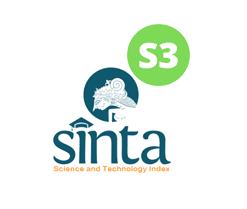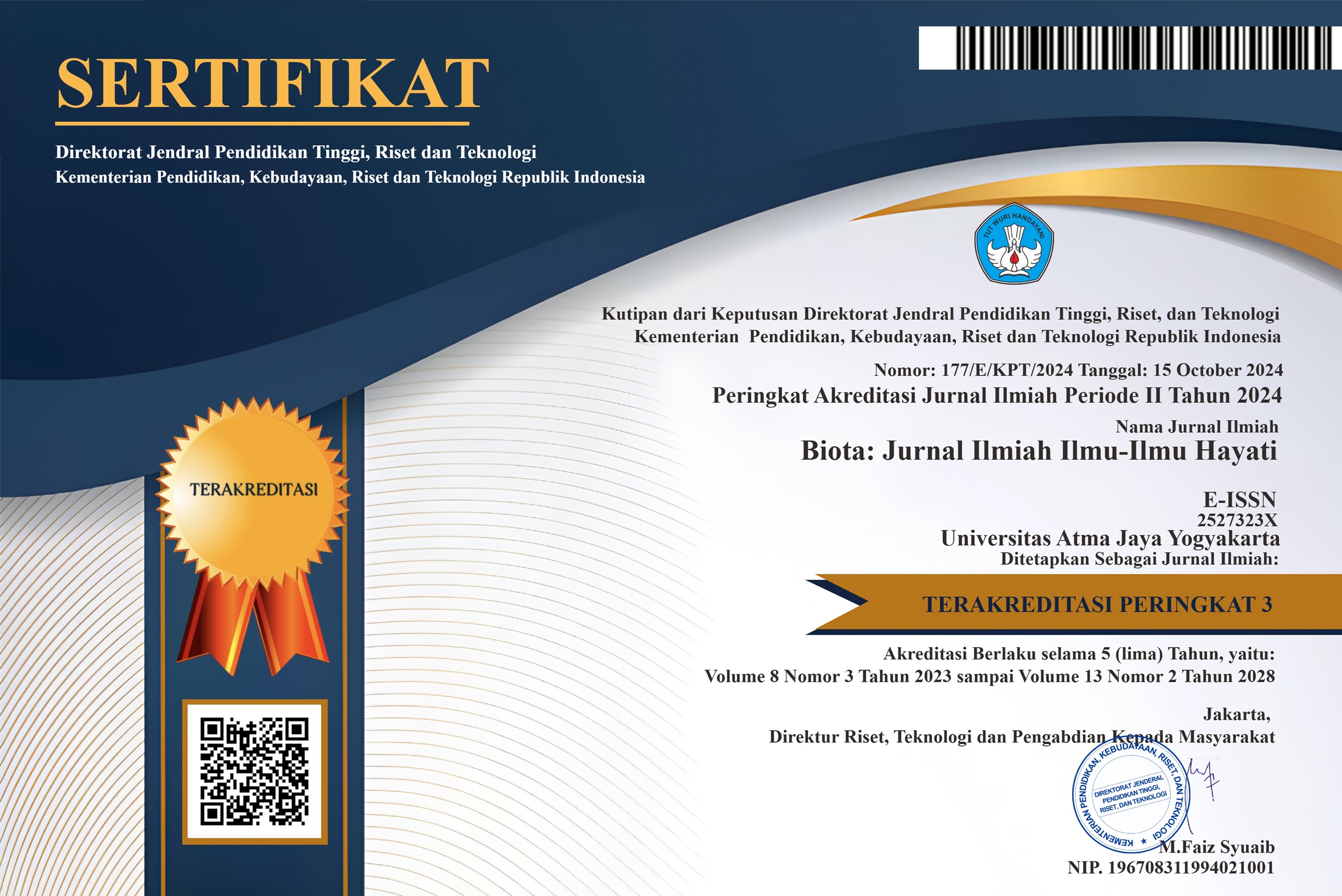Variasi Morfologi Bunga Anggrek Bulan Hybrida Phalaenopsisamabilis: Analisa Karakter dengan Pendekatan Numerik
DOI:
https://doi.org/10.24002/biota.v7i1.4207Keywords:
Phalaenopsis amabilis, hibrida, variasi, morfologi, pendekatan numerical, anggrekAbstract
Informasi mengenai keanekaragaman bunga hibrida Phalaenopsis amabilis sebagai tanaman hias telah terdokumentasi secara lengkap. Namun, karakter yang menentukan varietas bunga masih belum teridentifikasi. Oleh karena itu penelitian ini akan mengeksplorasi dan mengidentifikasi karakter morfologi yang berperan dalam pembentukan keanekaragaman Phalaenopsis amabilis. Secara keseluruhan terdapat tiga puluh lima karakter morfologi yang terbagi menjadi sebelas sifat vegetatif dan dua puluh empat sifat generatif yang digunakan untuk menganalisis enam belas sampel anggrek. Enam belas sampel tanaman anggrek Phalaenopsis amabilis teridentifikasi sebagai delapan varietas. Delapan varietas tersebut kemudian dianalisis menggunakan PATN versi 4.00. Hasil analisis menunjukkan bahwa baik sifat vegetatif maupun generatif dapat digunakan sebagai indikator identifikasi dan penentuan verietas Phalaenopsis amabilis. Dua klaster hierarkis dalam setiap dendrogram analisis sifat vegetatif, sifat generatif atau gabungan keduanya menunjukkan dua kelompok varietas. Karakter morfologi batang, daun dan bunga merupakan parameter yang menentukan keanekaragaman varietas dari Phalaenopsis amabilis.
References
Aloysius, S., Purwantoro, A., Dewi, K & Semiarti, E. (2018). Phenotypic variation and genetic alteration of Spathoglottis plicata resulted from in vitro cultured seed irradiated with X-Ray. Biodiversitas 19(5): 1642-1648.
Baker, M.L & Baker, C.O. (1996). Orchid species culture-Dendrobium. Timber Press. Oregon.
Belbin, L. (2013). PATN software verse 4.00. CSIRO. Canberra.
Burke, J.M & Adams, P.B. (2002). Variation in the Dendrobium speciosum (Orchidaceae) complex: A numerical approach to the species problem. Australian Systematic Botany 15(1): 63-80.
De, L.C. (2020). Morphological diversity in orchids. International Journal of Botany Study 5(5): 229-238.
Hartati, S., Muliawati, E.S., Pardono, Cahyono, O & Yuliyanto, P. (2019). Morphological Characterization of Coelogyne spp for germ plasm conservation of orchids. Rev. Ceres, Viçosa 66(4): 265-270.
Internicola, A.I., Page, P.A., Bernasconi, G & Gigord, L.D.B. (2007). Competition for pollinator visitation between deceptive and rewarding artificial inflorescences: an experimental test of the effects of floral colour similarity and spatial mingling. Funct Ecol 21:864–872.
Iswanto, H. (2002). Petunjuk perawatan anggrek. Agromedia Pustaka. Jakarta.
Lengyel, S. Gove, A.D., Latimer, A. Majer, J.D & Dunn, R.R. (2010). Convergent evolution of seed dispersal by ants, and phylogeny and biogeography in flowering plants: a global survey. Perspectives in Plant Ecology, Evolution and Systematics 12(1): 43–55.
Mahfut. (2019). Mengenal anggrek Phalaenopsis dan penyakit virus tanaman. Anugrah Utama Raharja. Bandar Lampung.
Manzano, P & Malo, J.E. (2006). Extreme long-distance seed dispersal via sheep. Frontiers in Ecology and the Environment 4 (5): 244–248.
Ostrowiecka, B., Tałałaj, I., Brzosko, E., Jermakowicz, E., Mirski, P., Kostro-Ambroziak, A., Mielczarek, L., Lason, A., Kupryjanowicz, J., Kotowicz, J & Wroblewska, A. (2019). Pollinators and visitors of the generalized food-deceptive orchid Dactylorhiza majalis in North-Eastern Poland. Biologia 74: 1247–1257.
Panal, C.L.T., Opiso, J.G & Opiso, G. (2015). Conservation status of the family Orchidaceae in Mt. Sinola, Arakan, North Cotabato, Philippines. Biodiversitas Vol. 16(2): 213-224.
Rianawati, S & Widiastoety, D. (2015). Pemuliaan anggrek Phalaenopsis. Hortikultura 11: 10-14.
Schlechter, R. (1982). The Orchidaceae of German New Guinea, eds. Blaxell, Katz and Simmons. The Australian Orchid Foundation. Melbourne.
Smith, F.Z., James, E.A & McLean, C.B. (2008). In Situ Morphometric study of Diuris punctata species complex (Orchidaceae), with implication for conservation. Australian Systematic Botany 21(4): 289-300.
Sneath, P.H., and Sokal, R.R. 1973. Numerical taxonomy.W.H. Freeman and Company, San Frnasisco.
Tini, E.W., Sulistyanto, P & Sumartono, G.H. (2019). Aklimatisasi Anggrek (Phalaepnopsis amabilis) dengan Media Tanam yang Berbeda dan Pemberian Pupuk Daun. J. Hort. Indonesia 10(2): 119-127.
Wati, K.W.C., Suamba, I.K & Dewi, I.A.L. (2015). Kinerja Usaha Tanaman Anggrek Bulan (Phalaenopsis Amabilis) Pada PT Multi Agro Bali Di Desa Sembung Kecamatan Mengwi Kabupaten Badung. Jurnal Agribisnis dan Agrowisata 4(1): 37-46.
Wenny, D.G & Levey, D.J. (1998). Directed seed dispersal by bellbirds in a tropical cloud forest. Proceedings of the National Academy of Sciences of the United States of America 95(11): 6204–6207.
Widiarsih, S & Dwimahyani, I. (2013). Aplikasi Iradiasi Gamma untuk Pemuliaan Mutasi Anggrek Bulan (Phalaenopsis amabilis Bl.) Umur Genjah.A Scientific Journal for The Applications of Isotopes and Radiation Vol. 9(1): 59-66.
Downloads
Published
How to Cite
Issue
Section
License
Copyright (c) 2022 Agustina Yohana Setyarini Arobaya

This work is licensed under a Creative Commons Attribution-NonCommercial 4.0 International License.
Authors who publish with Biota : Jurnal Ilmiah Ilmu-Ilmu Hayati agree to the following terms:
- Authors retain copyright and grant the Biota : Jurnal Ilmiah Ilmu-Ilmu Hayati right of first publication. Licensed under a Creative Commons Attribution-NonCommercial 4.0 International License that allows others to share the work with an acknowledgment of the work's authorship and initial publication in this journal.
- Authors are able to enter into separate, additional contractual arrangements for the non-exclusive distribution of the journal's published version of the work (e.g., post it to an institutional repository or publish it in a book), with an acknowledgment of its initial publication in Biota : Jurnal Ilmiah Ilmu-Ilmu Hayati, and as long as Author is not used for commercial purposes.













